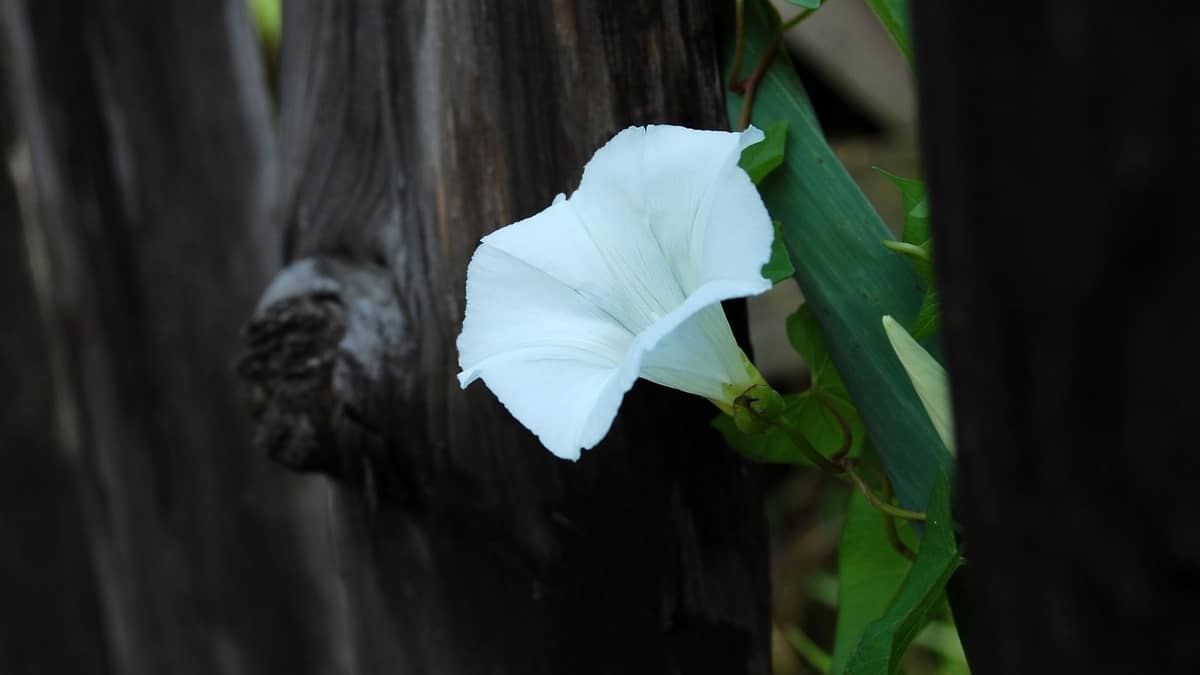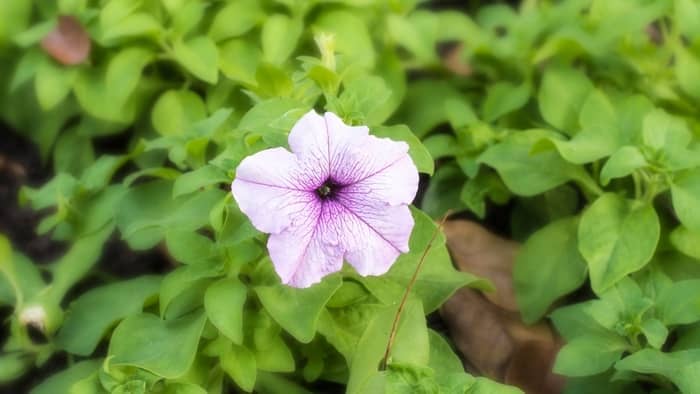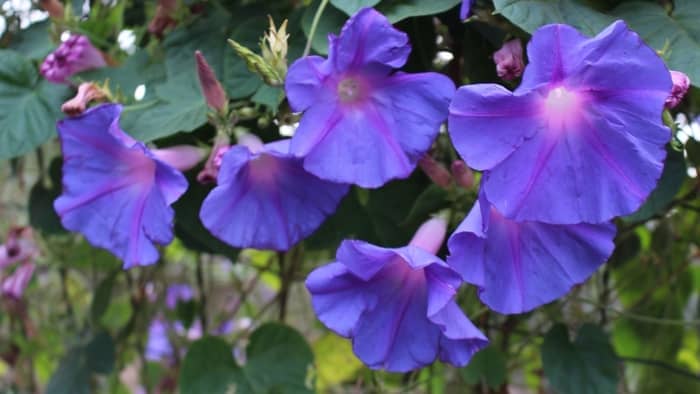Last Updated on March 5, 2022 by Guillermina
Perennial morning glory is a hanging flower that attracts hummingbirds due to its unique blooms. The trumpet-shaped flowers open up with the first sun rays, ready to feed the early rising hummers.
This plant is an aggressive climber, making it perfect for a romantic arch. Add the buzzing hummingbirds, and you have a cinderella story!
You might not know that there are two types of morning glory. Let’s help you pick the suitable one for your visitors.
What Is Perennial Morning Glory
Perennial morning glory, creeping jenny, possession vine, or field bindweed is a plant that belongs to the Convolvulaceae family. It’s native to Europe and Asia, where it’s considered an aggressive and invasive weed.
Unlike the annual morning glory, the perennial kind can be one of 2 colors, pink or white. The leaves are more arrowheaded; the vines are thicker and fuzzy. The flowers of the perennial morning glory are significantly smaller, ranging from 0.75 to 1 inch.
This morning glory blooms in mid-summer and produces seed pods afterward. The seed pods are often eaten or scattered by birds. The most interesting thing about the field bindweed is that its seeds are viable in the ground for 60 years. For comparison, most seeds are viable for up to 2 years.
Why Hummingbirds Love Morning Glories
The perennial morning glory has trumpet-shaped flowers that are effortlessly accessible for hummingbirds. Once they open in early to midsummer, the petals are bright pink making them easy to spot. Later on, the petals can turn white.
These flowers bloom from summer until the first fall freeze. They provide food for the hummingbirds that migrate at a later date when barely any natural nectar is around.
However, do hummingbirds get nectar from morning glories? Even the annual morning glories produce enough nectar to feed hummingbirds. They’re fast-growing vines with an abundance of flowers.
Read more about Yellow Flowering Vines
Plant Morning Glory For Hummingbirds
The perennial morning glory is rarely planted. However, it’s not uncommon to find it growing in your garden. But what are morning glories good for, besides attracting hummingbirds? If you have a section in your yard that feels dull, you can add greenery with the morning glory. The perennial morning glory is considered as aggressive as a weed so beware before planting.
Bees also love perennial morning glories. As the sun goes down, the morning glory flowers close. Some bees feed right before the flower closes and spend the night inside.
If you’re afraid of introducing a weed-like plant, then the annual morning glory is a safer choice. All you need to do is plant it where it can climb, provide an arch, a trellis or grow it next to a naked wall on the side of your house. Even though it’s an annual plan, it’s very likely to grow the following year on its own.
The flowers form seed pods that break as they mature. The seeds fall in the same spot, and you get a new morning glory in spring without any effort.
Growing Guide
- In late spring, go to your nearest garden center, or search through Amazon for morning glory seeds. Beware that annual morning glories come in several colors.
- Build a trellis or an arch. These vines can grow up to 20 feet so you need something they can climb on. Otherwise, they will occupy the ground.
- Soak the purchased seeds for 24 hours in warm water. Sow them the following day in well-draining soil, away from other plants. Morning glories, annual and perennial are aggressive feeders and can drain the soil from water and nutrients.
- These plants are drought-tolerant, so water sparingly.
- By midsummer, you’ll have a fully grown morning glory!
Draw Hummingbirds to the Morning Glories
Hummingbirds have perfect memory. Even if they’re migratory, they know where they fed last year and will come back to the same spot. So changing their feeding habits can be harder. If you wonder do hummingbirds like morning glory plants, they do, but they also need a little help to find them.
Plant the morning glory in full sun on a high arch with enough surface around for the hummingbird to wave its wings while feeding. Add a feeder nearby to draw the hummingbirds to your new flowers.
Other Vines Hummingbirds Love
Hummingbirds love vines as their flowers are usually pointed out, making them accessible for feeding on the go. If you love how vines look in your garden, you might want to plant some more hummer-friendly types. Just like the perennial morning glory some of them come back year after year, so you won’t have to worry about replanting.
Here are two suggestions, often referred to as hummingbird vines, due to a large number of visitors.
The cypress vine has red, white, or pink five-petal flowers, thin leaves and is part of the morning glory family. It’s perennial in USDA Hardiness zones 6 to 9 and highly decorative. You need to plant it after the last spring frost and follow the exact instructions for the morning glory.
The trumpet vine has large orange and red tubular flowers perfect for hungry hummingbirds. It’s perennial in zones 4 to 10 and can reach double the size of the perennial morning glory – up to 40 feet! Keep in mind that this is an invasive plant and can be hard to remove after a few years.
Final Say: You Need Perennial Morning Glory In Your Garden
Gardeners often criticize the perennial morning glory due to its invasiveness. But if you want to provide a natural nectar source for your hummingbirds, the morning glories are perfect. They grow fast and bloom from the middle of summer to the first fall frost. They’re very low maintenance, so you can grow them even if you have a brown thumb.
FAQs
Do hummingbirds like morning glory plants?
Yes, hummingbirds love morning glories. Some kinds are even called hummingbird vines due to many birds orbiting the flowers.
What perennials do hummingbirds love?
Bee balm, honeysuckle, zinnia, daylilies, and salvia are just a few of the perennial flowers hummingbirds love.
Do hummingbirds get nectar from morning glories?
Morning glories are rich in nectar. The flower's shape keeps the nectar accessible, which makes them popular among hummingbirds.
What are morning glories good for?
Morning glories are perfect for disguising parts of your garden or using them to form a shade over some sections. They're perfect for less experienced gardeners and gardens with mediocre soil.
Meri is a passionate wildlife enthusiast with a special interest in hummingbirds. She loves to observe and learn about the different species of hummingbirds from around the world. After graduating from college with a degree in biology, Meri decided to pursue her dream of writing about hummingbirds and the importance of their conservation. She has since published several articles on the subject in various magazines and online publications. Her articles focus on the importance of habitat preservation, how hummingbirds contribute to ecosystem balance, and the unique behaviors of various species. When she’s not writing, Meri enjoys bird watching and taking pictures of her feathered friends. She also volunteers at her local wildlife center, helping to protect and rehabilitate injured or orphaned hummingbirds. Meri’s passion for hummingbirds drives her to spread awareness and promote their conservation, so that future generations will be able to enjoy their beauty.




